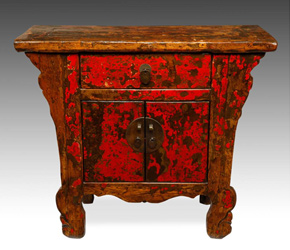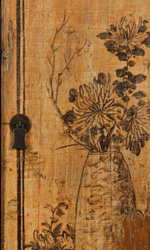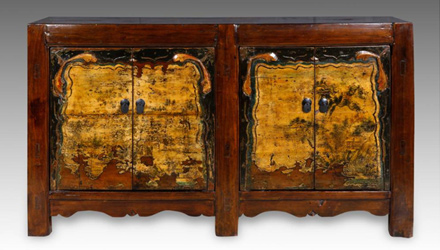| |
 |
| |
Chinese lacquered elm wood altar cabinet showing
various layers of lacquer and erosion down to
the wood surface |
Classical
Chinese
furniture
emphasized the natural beauty of expensive hardwoods, which were often waxed to give a glossy, resistant surface. Woods such as
Rosewood,
Zitan, Zelkova, and Hunghuali were highly prized. In contrast, Chinese vernacular furniture, a synonym for lacquered and painted furniture, was often made of softer woods, which could not attain the same high polish. Therefore, lacquer was used to protect, beautify, and polish the surface of this furniture. The most popular wood used in vernacular furniture was
Elmwood
.
 |
|
| A ground of rare salmon colored lacquer eroded all the way to the wood underneath |
|
Simply stated, lacquer was the most frequently used finish on vernacular furniture because it was the most versatile.
Lacquer
may be colored by adding pigment, and when dry may be decorated with carved or painted designs. The medium may be used to conceal exposed joints, less beautiful pieces of wood, and the joining of multiple, unmatched planks to give the appearance of a single piece of wood. The use of lacquer made it possible for carpenters to use every piece of wood available to them.
Lacquer
is made from the sap of the lacquer tree, and is considered the first natural plastic.
Lacquer
was graded according to the season in which it was collected, the age of the tree, and so on. Different types of lacquer were considered appropriate for different tasks. Since the fourth century, the making of lacquer has been highly organized in China. Because lacquer is so durable and dries so hard, it was used initially as a protective coating – for example, to create arrow-proof armor.
Lacquer
ware in good condition has even been recovered from archeological excavations.
When it came to finishing vernacular furniture there was no clear, correct approach. Every artisan had their own favorite lacquer and method of application, but there is universal agreement that lacquer was applied in multiple coats, each coat being allowed to dry before the next was put on. Oftentimes, lacquer of inferior grade was used for the initial coats, while the best was reserved for the final coats. The Chinese left no written record, or “how to” manual for the application of lacquer or the finishing of vernacular furniture, and if one did exist its rules were not followed with any degree of loyalty.
The Chinese were masters of layering different colors of lacquer to produce a desired tone or effect in the final finish. For example, to produce a red lacquer finish a craftsman might start with black, followed by dark red, followed by a lighter red. In between the coats of color would be layers of clear lacquer, all coats rubbed by hand to produce a final, deep, rich color with unusual luster. In addition, fabric might be laid down between coats to allow for greater adhesion and to give the final finish greater depth. As these finishes aged, they resulted in the extraordinary patinas that are so prized today.
Lacquered
Chinese vernacular furniture typically ages very well. Even the most weathered or abused piece may reveal a rich, warm patina when cleaned up. Mottled appearances, the wearing away of lacquer to reveal the underlying wood or additional layers of color are effects exposing the heritage and allure of these pieces. It should be noted, the goal of restoration as it is practiced at PRIMITIVE is not to strip away these effects to create a “like new” piece of furniture, but instead, to re-establish the original character of the piece aside from the ravages of time and use. When effective, lacquered vernacular furniture becomes a lively addition to any room or collection as well as prized possessions.
 Chinese lacquered and painted pine wood cabinet Chinese lacquered and painted pine wood cabinet |
| |
|
Download this Article: Lacquering of Chinese Furniture.pdf


